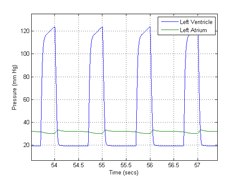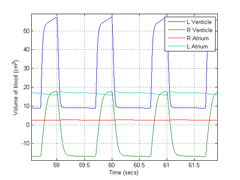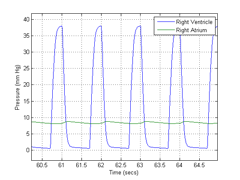Research
Contact Info
Downloads

Physiological Modeling
We are currently researching various methods and techniques of modeling physiological systems through the use of mathematical models. We have currently developed a cardiovascular model using highly non-linear relationships between pressure and volume. The system consists of the model of a heart (4 chambers), Lung, Pulmonary system, arterial segment, peripheral (lumped), Venous segment and Vena Cava. The model simulates blood flow rate, blood volume and pressures in all segments.

The model consists of approx. 70 tunable state parameters that can impact the simulation results in real-time. These parameters are tuned to provide the required response to medication or for simulation of patient pathologies. The nominal simulation parameters are tuned to provide normal human physiological behaviour based on experimental data as briefly described in the figure below.

We are currently extending the model to incorporate the effects of certain behaviours effect such as primary, secondary and tertiary effects into the mathematical model to provide realistic responses to external stimuli such as administration of medication, pain, stress, fear and other stimuli. The figure briefly shows the effects of some of the stimuli on the human physiology.

The simulation can currently provide real-time results of effects of different types of pathology such as increased arterial resistance due to narrow vessels or other causes, Simulate Heart valve failure such as prolapse valves and Myocardical infarction.
Below show a few plots of the simulation results of a simple nominal simulation run of the current model.








